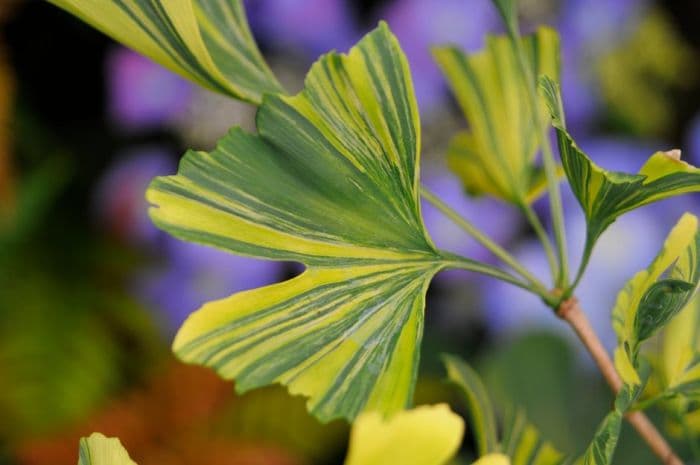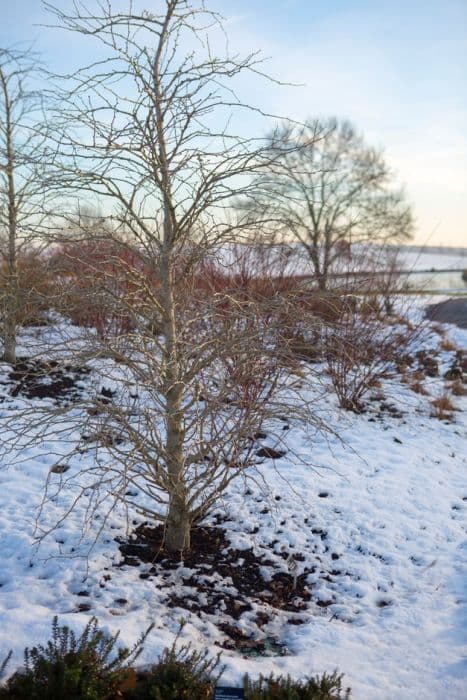Maidenhair tree 'California Sunset' Ginkgo biloba 'California Sunset'

ABOUT
'California Sunset' is a deciduous, large tree or small shrub to around 4m tall. Fan-shaped leaves emerge a pale creamy-yellow in spring before maturing to dark green with irregular streaks of creamy-yellow in summer
About this plant
 Names
NamesFamily
Ginkgoaceae.
Synonyms
California Sunset Ginkgo, Maidenhair Tree.
Common names
Ginkgo biloba 'California Sunset'.
 Characteristics
CharacteristicsLife cycle
Perennials
Foliage type
Deciduous
Color of leaves
Varies
Height
35 feet [10.7 meters]
Spread
30 feet [9.1 meters]
Plant type
Tree
Hardiness zones
Varies
Native area
China
Benefits
 General Benefits
General Benefits- Ornamental Appeal: Adds aesthetic value to gardens with its unique fan-shaped leaves that have splashes of yellow, giving a 'sunset' effect.
- Shade Provider: Can grow to a substantial size offering shade in larger gardens or public parks.
- Drought Resistance: Once established, it requires minimal watering and can withstand periods of dry weather.
- Cold Hardy: Capable of surviving in cooler climates, making it versatile for various landscapes.
- Longevity: Known to be a long-lived tree, providing lasting value to the landscape.
- Urban Environment Suitability: Tolerates pollution and confined soil spaces, making it ideal for city planting.
- Seasonal Interest: Exhibits a striking display of golden-yellow foliage in the fall.
- Low Maintenance: Requires little pruning or special care once established.
- Wildlife Attraction: The tree is known to attract birds and insects, which can benefit local ecosystems.
- Resistance to Pests: Generally resistant to many pests, reducing the need for chemical treatments.
 Medical Properties
Medical Properties- Circulatory Health: Ginkgo biloba is often used for its potential benefits in improving blood circulation and has been studied for its effects on peripheral artery disease.
- Cognitive Function: It is commonly associated with cognitive function, memory support, and is being researched for its possible role in treating dementia and Alzheimer's disease.
- Antioxidant Properties: Ginkgo contains flavonoids and terpenoids that may have antioxidant effects, helping to combat oxidative stress and inflammation in the body.
- Anxiety and Depression: Some studies suggest that Ginkgo biloba may have beneficial effects on mood disorders like anxiety and depression, possibly as a result of its impact on neurotransmitter systems.
- Premenstrual Syndrome (PMS): There is evidence to suggest that Ginkgo biloba may reduce symptoms associated with PMS, including mood swings and breast tenderness.
- Vision and Eye Health: Due to its blood flow enhancing effects, there's interest in Ginkgo biloba for improving eye health and treating glaucoma and age-related macular degeneration (AMD).
- Tinnitus: Ginkgo biloba has been explored as a treatment for tinnitus, although results are mixed and more research is needed to confirm its efficacy.
 Air-purifying Qualities
Air-purifying QualitiesThis plant is not specifically known for air purifying qualities.
 Other Uses
Other Uses- Artistic inspiration: Ginkgo leaves have a unique fan shape that is often used in jewelry design, graphic art, and as a motif in decorative arts.
- Dye production: The leaves of the Ginkgo can be used to create a natural dye for fabrics, yielding a range of colors from yellows to greens.
- Culinary decoration: The distinctive leaves can be used to add an artistic touch to presentation in gourmet dishes.
- Gardening: Ginkgo is used in bonsai cultivation for its aesthetic foliage and the ability to adapt to pruning and shaping.
- Photography subjects: The unique shape and bright yellow fall color of Ginkgo leaves make them a favorite subject for photographers, especially in autumn.
- Craft materials: Dried Ginkgo leaves can be used in crafting, such as in making bookmarks, potpourri, or pressed leaf artwork.
- Wedding decor: Due to their beauty and symbolic meaning, Ginkgo leaves and branches are sometimes used in wedding bouquets and decorations.
- Learning tools: Due to their distinct features, Ginkgo leaves are often used in educational settings to teach about plant morphology and botany.
- Folklore and storytelling: In certain cultures, the Ginkgo may be incorporated into stories and legends, often symbolizing longevity and resilience.
- Biological studies: Ginkgo trees, being one of the oldest living tree species, are studied for their exceptional resistance to disease and stress factors.
Interesting Facts
 Feng Shui
Feng ShuiThe Ginkgo tree is not specifically mentioned in traditional Feng Shui practices; however, as a general guideline, plants can be used to enhance the wood element in Feng Shui. A healthy Ginkgo tree placed in the east sector of a garden or home could promote health and family harmony or in the southeast to attract wealth and abundance.
 Zodiac Sign Compitability
Zodiac Sign CompitabilityThe Ginkgo tree is not used in astrology practice.
 Plant Symbolism
Plant Symbolism- Longevity: Ginkgo biloba is one of the oldest living tree species and is often associated with long life and endurance.
- Resilience: Having survived natural disasters and changes over the millennia, the ginkgo represents the ability to withstand adversity.
- Hope and Peace: Ginkgo trees were one of the few living things to survive the atomic bombings in Japan, making them a symbol of hope and the resilience of life, as well as peace.
- Love: In some cultures, Ginkgos are seen as symbols of love and duality, perhaps due to their characteristic fan-shaped leaves with two lobes.
- Memory and Cognition: Due to ginkgo's use in herbal medicine to aid memory and cognitive function, it has come to symbolize mental sharpness and clarity.
 Water
WaterThe Maidenhair Tree should be watered deeply once a week, allowing the water to penetrate the soil to a depth of several inches. During hot or dry periods, increase watering frequency to twice a week, providing about 1-2 gallons per session for young trees and up to 5 gallons for mature trees. Avoid overwatering as this can lead to root rot; the soil should be moist but not waterlogged. In the winter, reduce watering to every few weeks, just enough to prevent the soil from completely drying out. Adjust the schedule based on rainfall and changes in weather conditions to ensure the soil remains consistently moist.
 Light
LightThe Maidenhair Tree thrives in full sunlight, requiring at least 6 hours of direct sun per day. It should be planted in a location where it can receive unfiltered sunlight throughout the day. Partial shade is tolerable, but the plant may not grow as vigorously or produce as many leaves. The ideal spot is open and sunny, away from buildings or other structures that could cast significant shadows on the tree.
 Temperature
TemperatureThe Maidenhair Tree is highly adaptable and can withstand a wide range of temperatures. It can survive in temperatures as low as -30°F and as high as 104°F. However, the ideal temperature range for this plant is between 35°F and 85°F. The tree is dormant in winter and can tolerate the cold but performs best when the temperature is moderate.
 Pruning
PruningThe Maidenhair Tree requires minimal pruning, mainly to remove dead or broken branches and to maintain its shape. The best time for pruning is in the late winter or early spring before the new growth begins. Prune sparingly to avoid unnecessary stress to the tree. It is not generally necessary to prune for size or shape unless the tree is being grown in a confined space or as a bonsai.
 Cleaning
CleaningAs needed
 Soil
SoilGinkgo biloba, commonly known as the maidenhair tree, thrives best in a well-draining soil mix composed of loamy or sandy soil. A pH range of 5.0 to 8.0 is suitable, ensuring a slightly acidic to alkaline environment. An ideal soil mix can be made by combining garden soil, coarse sand, and organic compost in equal parts, which helps in providing good aeration and nutrients.
 Repotting
RepottingMaidenhair trees are slow-growing and do not need frequent repotting. Young trees can be repotted once every two to three years. However, as they mature, repotting can be done less frequently, only when the tree becomes root-bound or the soil appears to be depleted.
 Humidity & Misting
Humidity & MistingMaidenhair trees are highly adaptable and can tolerate a wide range of humidity levels. They do not require high humidity to thrive and can do well in average outdoor humidity conditions. Indoors, maintaining a normal room humidity will suffice for the health of the plant.
 Suitable locations
Suitable locationsIndoor
Place in bright, indirect light, away from drafts; water when topsoil dries.
Outdoor
Plant in full sun to partial shade; protect from strong winds.
Hardiness zone
3-8 USDA
 Life cycle
Life cycleGinkgo biloba 'California Sunset', also known as the Maidenhair Tree, starts its life cycle as a seed which, upon germination, develops into a young sapling with distinct fan-shaped leaves. As it grows, it enters a juvenile phase characterized by rapid vertical growth and begins to establish its root system. After several years, it reaches maturity and can start reproducing; the 'California Sunset' cultivar does not typically produce fruit, as it is often a male clone. Mature Maidenhair Trees develop a broad crown and can live for several centuries, becoming more resistant to pests and diseases with age. Each year, the tree undergoes a seasonal cycle of leafing out in spring, vigorous growth in summer, and leaf drop in autumn, exhibiting a stunning display of golden-yellow foliage before becoming dormant in winter. Towards the end of its life cycle, a Ginkgo biloba 'California Sunset' may experience reduced growth and gradual decline before eventually dying, completing its life cycle.
 Propogation
PropogationPropogation time
Spring-Early Summer
The Ginkgo biloba 'California Sunset', commonly known as the Ginkgo or Maidenhair Tree, is typically propagated by seed or by grafting. The most popular method is grafting, which involves taking a piece of a mature ginkgo tree that displays the desired characteristics and attaching it onto a compatible rootstock. This is generally done during the dormant season, late winter to early spring, to ensure that the graft has time to heal and establish before the growing season begins. The scion, or the piece that is to be grafted, is usually about 4 to 6 inches (10 to 15 centimeters) long, and it is joined to the rootstock through various grafting techniques such as whip grafting or bud grafting. The graft union is then sealed with grafting wax or tape to prevent drying out and infection, and the new plant is monitored closely as it grows to ensure the graft is successful.




